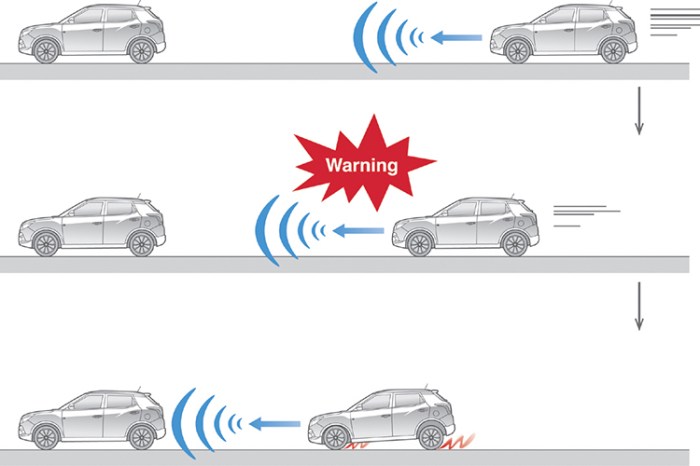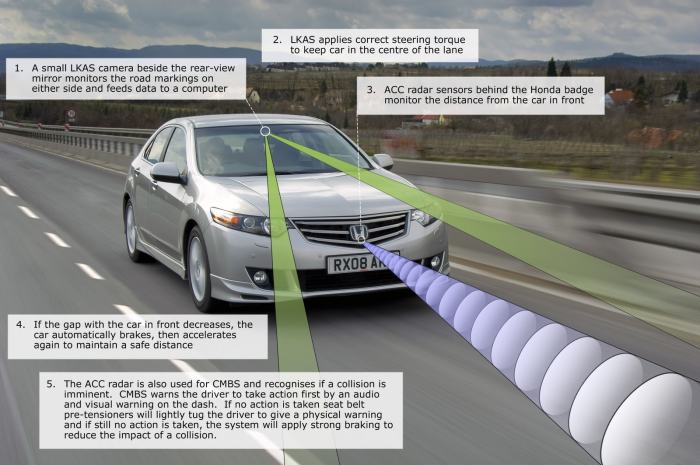Toyota will make automatic braking near standard by next year – Toyota Makes Automatic Braking Nearly Standard by Next Year, signaling a significant shift in the automotive industry towards prioritizing safety. This decision is poised to have a profound impact on road safety, with the potential to drastically reduce accidents and injuries. By making this crucial technology readily available, Toyota is setting a new standard for vehicle safety and encouraging other automakers to follow suit.
This move reflects the rapid advancements in automatic braking technology, which has become more accessible and reliable than ever before. These systems, now capable of detecting potential collisions and automatically applying brakes, have proven effective in preventing accidents. As the technology continues to evolve, we can expect even more sophisticated systems with enhanced capabilities, further bolstering road safety.
Impact on Safety

Toyota’s decision to make automatic braking standard on its vehicles has the potential to significantly enhance road safety and reduce accidents and injuries. This move aligns with the growing trend of incorporating advanced driver-assistance systems (ADAS) into vehicles, aiming to prevent or mitigate collisions.
Automatic Braking Systems and Accident Reduction
The effectiveness of automatic braking systems (ABS) in preventing collisions is well-documented. Numerous studies and real-world data have demonstrated their ability to reduce rear-end collisions, a common type of accident. ABS can quickly apply the brakes when the system detects an imminent collision, often preventing or mitigating the impact.
Consumer Perception and Adoption: Toyota Will Make Automatic Braking Near Standard By Next Year
The widespread adoption of automatic braking systems (ABS) is likely to significantly impact consumer perception of vehicle safety. As this technology becomes more common, drivers are expected to develop a greater sense of trust in their vehicles’ ability to prevent accidents. This shift in perception could lead to a more relaxed driving experience, potentially influencing driver behavior and ultimately impacting road safety.
Factors Influencing Adoption
Several factors will influence the adoption of automatic braking technology. These include:
- Cost: The cost of the technology is a significant factor, and as the technology becomes more standard, the price is expected to decrease, making it more accessible to a wider range of consumers.
- Effectiveness: Consumers will be more likely to adopt the technology if they believe it is effective in preventing accidents.
- Awareness: Increased awareness and education about the benefits of automatic braking systems will play a crucial role in promoting adoption.
- Regulations: Government regulations and safety standards that mandate or incentivize the use of automatic braking systems will also influence adoption rates.
Benefits and Drawbacks of Automatic Braking Systems
The table below summarizes the potential benefits and drawbacks of automatic braking systems:
| Benefits | Drawbacks |
|---|---|
| Reduced risk of accidents | Potential for false positives, leading to unnecessary braking |
| Improved safety for drivers and passengers | Limited effectiveness in certain situations, such as when the vehicle is traveling at high speeds or in adverse weather conditions |
| Increased driver confidence | Possible reliance on the technology, potentially leading to less attentive driving |
| Reduced insurance premiums | Potential for increased maintenance costs |
Industry Implications
Toyota’s decision to make automatic emergency braking (AEB) a standard feature on its vehicles by next year has significant implications for the automotive industry as a whole. This move sets a precedent and could potentially influence other automakers to follow suit, ultimately leading to a more safety-focused future for car design.
Impact on Other Automakers
The decision by Toyota, a major player in the automotive industry, to make AEB standard is likely to have a ripple effect on other automakers. This is due to several factors:
- Competitive Pressure: Other automakers will face pressure to match Toyota’s safety features to remain competitive in the market. Consumers increasingly value safety features, and offering comparable technology becomes crucial for attracting buyers.
- Consumer Demand: As AEB becomes more prevalent, consumer expectations will rise. Customers will likely demand similar safety features in other vehicles, creating a market demand for widespread adoption.
- Regulatory Influence: Governments worldwide are increasingly pushing for mandatory safety features, including AEB. Toyota’s move could encourage regulators to implement stricter regulations, further influencing the industry.
Future of Car Safety Features, Toyota will make automatic braking near standard by next year
Toyota’s decision could accelerate the development and adoption of advanced driver-assistance systems (ADAS) in the future.
- Increased Investment: Automakers may allocate more resources to research and development of ADAS technologies, leading to advancements in areas like lane departure warning, adaptive cruise control, and blind spot monitoring.
- Technological Integration: The integration of ADAS features into vehicles will likely become more seamless and user-friendly, making them more accessible and appealing to consumers.
- Data-Driven Safety: The use of data from AEB systems and other ADAS technologies will provide valuable insights into real-world driving scenarios, enabling the development of more effective safety features.
Cost and Accessibility

The widespread adoption of automatic braking systems (ABS) will undoubtedly have a significant impact on vehicle prices. While the benefits of ABS are undeniable, understanding the cost implications and their potential effects on affordability is crucial.
This section delves into the financial aspects of implementing ABS, examining how these costs might influence vehicle prices and accessibility for different consumer segments.
Impact on Vehicle Prices
The cost of implementing ABS varies depending on the complexity of the system and the vehicle model. Generally, advanced ABS systems, which often include features like adaptive cruise control and lane departure warning, are more expensive to manufacture and integrate.
The increased production costs associated with ABS are likely to be reflected in the final selling price of vehicles. This price increase may be more pronounced in lower-priced models, where the cost of ABS represents a larger percentage of the overall vehicle cost.
The cost of implementing ABS can range from a few hundred dollars for basic systems to several thousand dollars for more advanced features.
Potential Impact on Affordability
The price increase associated with ABS could potentially impact the affordability of vehicles for certain consumer segments.
* Lower-income households: Individuals with limited financial resources may find it more challenging to afford vehicles equipped with ABS, particularly if the price increase is significant.
* First-time buyers: New drivers and those entering the market for the first time may face a higher entry barrier due to the increased cost of vehicles with ABS.
While the potential impact on affordability is a concern, it’s important to consider the long-term benefits of ABS. The increased safety provided by these systems could potentially offset the initial cost through reduced insurance premiums and lower repair costs in the event of an accident.
Cost Differences Between Vehicles with and Without Automatic Braking
The following table illustrates potential cost differences between vehicles with and without automatic braking, based on a hypothetical example:
| Vehicle Model | Price Without ABS | Price With ABS | Cost Difference |
|—|—|—|—|
| Compact Sedan | $20,000 | $21,500 | $1,500 |
| Mid-size SUV | $35,000 | $37,000 | $2,000 |
| Luxury Sedan | $50,000 | $52,500 | $2,500 |
It’s important to note that these figures are for illustrative purposes only and actual costs may vary depending on the specific vehicle model, manufacturer, and market conditions.
Toyota’s decision to make automatic braking near standard by next year marks a significant step towards a future where accidents are minimized and roads are safer. By prioritizing this technology, Toyota is not only enhancing the safety of its vehicles but also setting a precedent for the entire automotive industry. As more manufacturers embrace this technology, we can expect a future where automatic braking becomes the norm, making roads safer for everyone.
Toyota’s commitment to safety is evident in their plan to make automatic braking a near-standard feature by next year. This focus on driver assistance systems is reminiscent of the innovative spirit of Redbox, who are reportedly developing a video streaming service again, redbox reportedly developing video streaming service again. Just as Redbox disrupted the physical rental market, Toyota is aiming to transform the automotive landscape by making advanced safety features accessible to more drivers.